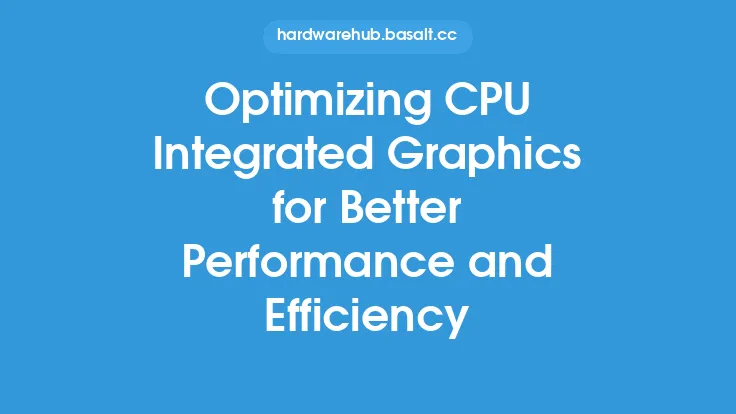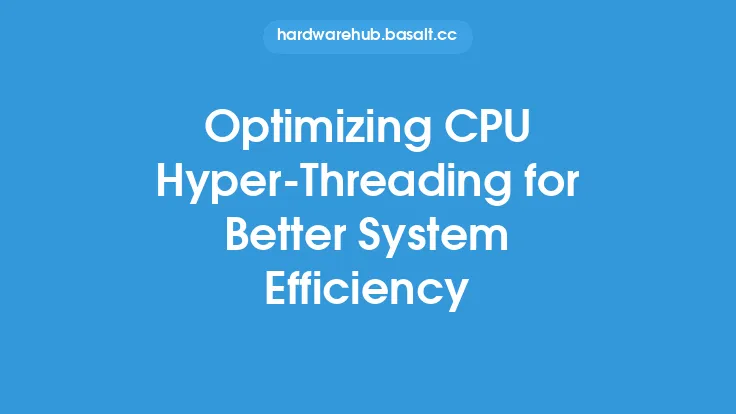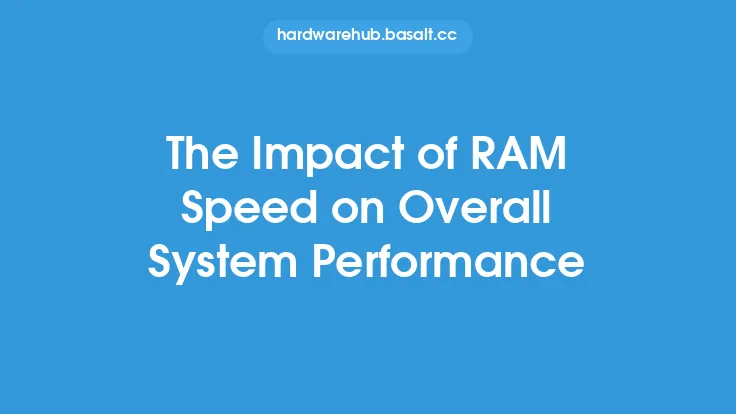When it comes to optimizing system efficiency, one crucial aspect to consider is RAM speed. Random Access Memory (RAM) plays a vital role in determining how quickly your system can access and process data. In this article, we will delve into the world of RAM speed, exploring the factors that affect it, how to optimize it, and the benefits of doing so.
Understanding RAM Speed
RAM speed refers to the rate at which your system's RAM can transfer data. It is typically measured in megahertz (MHz) or gigahertz (GHz) and is often expressed as a series of numbers, such as 3200MHz or 3600MHz. The speed of your RAM can significantly impact your system's overall performance, as it determines how quickly your CPU can access the data it needs to perform tasks. Faster RAM speeds can result in improved system responsiveness, reduced lag, and increased productivity.
Factors Affecting RAM Speed
Several factors can affect RAM speed, including the type of RAM used, the motherboard's capabilities, and the system's configuration. One key factor is the type of RAM used, with different types such as DDR3, DDR4, and DDR5 offering varying speeds. For example, DDR4 RAM typically offers speeds ranging from 2133MHz to 3200MHz, while DDR5 RAM can reach speeds of up to 6400MHz. The motherboard's capabilities also play a significant role, as it must be able to support the desired RAM speed. Additionally, the system's configuration, including the number of RAM modules installed and their placement, can impact RAM speed.
Optimizing RAM Speed
To optimize RAM speed, several steps can be taken. One approach is to upgrade to faster RAM modules, such as switching from DDR4 to DDR5. However, this may require a motherboard upgrade as well, as older motherboards may not support the newer, faster RAM types. Another approach is to adjust the RAM timings, which refer to the delay between when the CPU requests data and when it is available. Tighter timings can result in improved performance, but may also increase the risk of system instability. It is essential to find a balance between speed and stability when optimizing RAM timings.
RAM Timings and Their Impact on Speed
RAM timings, also known as latency, play a crucial role in determining RAM speed. There are several key timings to consider, including CAS (Column Address Strobe) latency, RAS (Row Address Strobe) latency, and command rate. CAS latency refers to the delay between when the CPU requests data and when it is available, while RAS latency refers to the delay between when the CPU requests data and when the RAM module is ready to provide it. Command rate, on the other hand, refers to the number of clock cycles required to execute a command. Optimizing these timings can result in improved RAM speed and overall system performance.
The Role of Motherboard and CPU in RAM Speed
The motherboard and CPU also play significant roles in determining RAM speed. The motherboard must be able to support the desired RAM speed, and the CPU must be able to handle the increased data transfer rates. Some motherboards may have limitations on the maximum RAM speed they can support, while others may require specific configurations to achieve optimal performance. The CPU, on the other hand, must have a high enough clock speed to take advantage of the faster RAM speeds. A balance between the CPU and RAM speeds is essential to achieve optimal system performance.
Benefits of Optimizing RAM Speed
Optimizing RAM speed can have several benefits, including improved system responsiveness, reduced lag, and increased productivity. Faster RAM speeds can also result in improved performance in applications that rely heavily on RAM, such as video editing and gaming. Additionally, optimizing RAM speed can help to reduce the risk of system crashes and instability, as it can help to prevent data bottlenecks and ensure that the system can handle demanding workloads.
Best Practices for Optimizing RAM Speed
To optimize RAM speed, several best practices can be followed. One approach is to use high-quality RAM modules that are designed for high-performance systems. It is also essential to ensure that the motherboard and CPU are capable of supporting the desired RAM speed. Additionally, adjusting the RAM timings and configuring the system for optimal performance can help to achieve the best possible RAM speed. It is also important to monitor system performance and adjust the RAM settings as needed to ensure that the system is running at its best.
Conclusion
In conclusion, optimizing RAM speed is a crucial aspect of achieving better system efficiency. By understanding the factors that affect RAM speed, optimizing RAM timings, and using high-quality RAM modules, users can improve their system's overall performance and responsiveness. The motherboard and CPU also play significant roles in determining RAM speed, and a balance between these components is essential to achieve optimal system performance. By following best practices and taking a holistic approach to system optimization, users can unlock the full potential of their system and enjoy improved performance, productivity, and overall computing experience.





